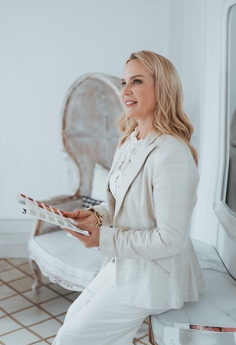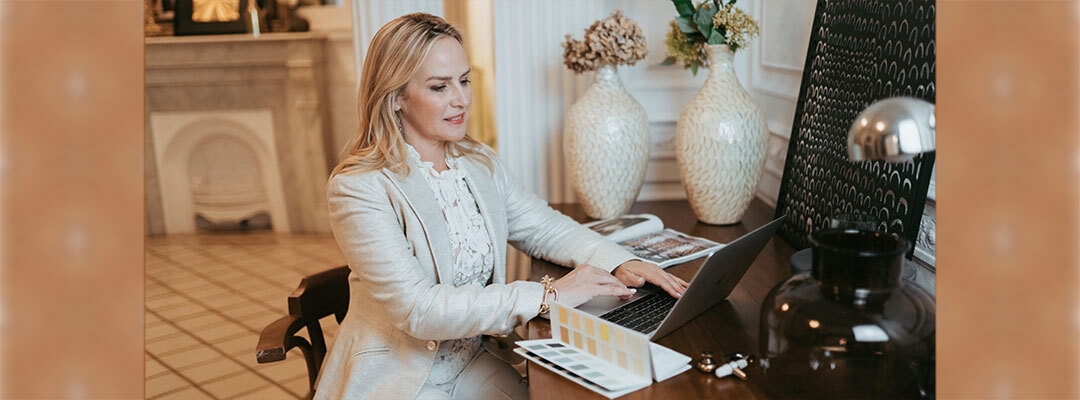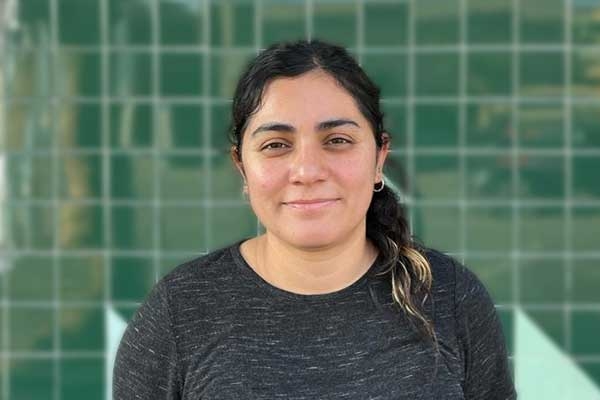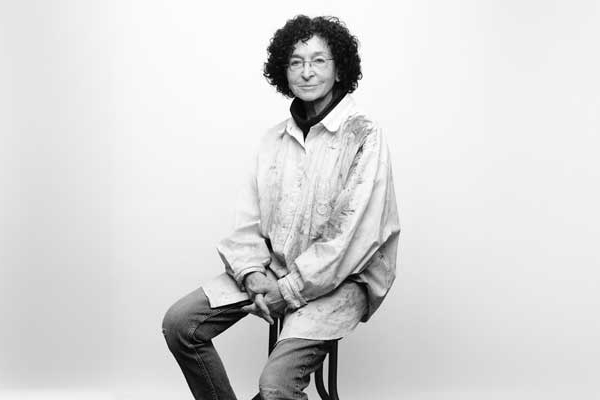“My appreciation for space planning and design is born from early childhood experiences,” says Certificate Program in Interior Design graduate Amber Lowi, who is also founder and principal designer of Amber Lowi Designs, in her #DesignLife blog.
Amber grew up in a small house—one with a single bathroom that was shared by three sisters—in a small town in Oregon. She notes in her blog, “Finding a way to make a tiny sliver of space my own was a constant mission—I was obsessed with organization and finding calm in the smallest ways. With each success my appreciation for well-designed personal space was seeded.”
Her deep appreciation for the beauty in good design was sparked. “I loved the idea that everyday things could also be lovely to look at.”
The feelings Amber would experience when presented with a good design—happiness, constraint, ethereal lightness, darkness, oppression, peaceful, calm—affected her, and she calls this the “why” in design: Why she eventually found her calling in a career that had always lived inside her.
Amber’s career path wasn’t straightforward. But each past decision has influenced her current success in interior design.
There’s Something to Be Said for Aesthetics
Amber attended Brigham Young University and earned her bachelor’s degree in communication, which led to an opportunity to be a news writer and an associate producer of the evening news in Hawaii. After graduation, she found herself in the sun-filled paradise of Waikiki, only instead of views of a world-famous beach, she spent her days in an “one-story, cinder-block building with dubious air conditioning and no outside windows.” Inside, a cluttered newsroom laid out in what she describes as a chaotic (if any) design concept.
The 24/7 newscycle combined with the drab physical work environment took its toll on Amber. “I only worked in news production for a few years,” she says. “I loved it while doing it, but I also understood I didn’t want a long-term career in news broadcasting.”
When it was time for a change, Amber returned to the West Coast, landing in San Francisco during the rise of the Bay Area tech boom in 1996. Here, she was slated to work in television at an Internet startup that ended up shuttering soon after her arrival. However, because of her newsroom writing background, Amber found a temp position at Robertson Stephens, a San Francisco investment bank that “focused on all things technology.”
That job turned into a long-term opportunity as a senior associate in corporate finance for the semiconductor and digital media industries. It was still a long way from her dream job.
Amber spent six years working in what she describes in her blog as “a fishbowl with minimal privacy,” but still she made numerous attempts to create personal space. The importance of good interior design began to show itself again, as day after day she entered the stereotypical high-rise building and the company’s floor of cubicles. Her time in the office, as well as the work adventures she went on, informed her growing desire to make a difference in the limited spaces we occupy.
According to her blog: “My confined space lesson extended to airplanes and lots of travel. I saw many different ways people created their spaces in the world, and as I began capturing images of those places, my passion for people’s stories and their space in the world deepened with each new stamp in the passport.
“These moments were jolts of creativity for my brain, and every once in a while I found a unique piece to bring back to my office apartment. A memory of a place and a touchstone that reminded me that there was a world outside of my work life. Interspersed with my file folders and research documents, I would place the smallest of plants—succulents—to add an element of greenery to my fishbowl. These small items brought joy.”
Committed to Understanding Why Design
“I enjoy research and always intended to get a master’s degree at some point in my life,” Amber tells me. But she didn’t end up going to graduate school for interior design, per se. Instead, she earned a master’s degree in psychology from San Francisco State University.

“In my various career choices, understanding why people make the choices they do has always been the most important factor for my success,” she explains. “I wanted to understand this further.”
In addition to learning about how the mind works, Amber learned firsthand the effects on herself after working in a communal space in a cramped psychology research lab. “This was the era my love for unique personal space was sparked,” she comments in her blog.
In 2002, Amber became a managing member of The Grandview Group, LLC., which focuses on the research, investment and development of real estate projects in distressed, residential real estate markets within California, Florida and Massachusetts. The business took her growing knowledge of the real estate industry and combined it with her commitment to good design.
This was only a stepping stone on her career path to design and architecture.
Seven years later, she also entered into a partnership with a friend in San Diego, forming Canter International North. Here, the focus was on distressed properties that were mostly trustee sales in Northern California. The firm purchased the homes and then renovated and resold them.
“I used the skills that I learned as a senior associate in investment banking to analyze properties and real estate markets,” she says. “This was the catalyst to lean into the design field.”
Amber was part of a small team that did it all: identifying properties, analyzing financials, changing locks, hiring contractors, planting flowers, vetting realtors, staging furniture. On her blog, she writes, “Rehabilitating these dilapidated and uncared-for properties and turning them into something useful with some attention to detail was incredibly fulfilling. And that is the moment #DesignLife was born.”
To Live in a More Beautiful World
“Because I was analyzing—and then managing—the various construction projects and renovations for these previously mentioned partnerships, there came a moment when I was making big design decisions,” Amber recalls. “As someone who firmly believes in having the tools necessary for success, I realized that I needed to be formally educated in the design process. I needed to understand the principles of classical design. After all, you can’t break the rules until you know what they are.”
And so she began to dabble with some of our design courses. “I took a few to start, had some life events that slowed my progress and then came back to finish the program in 2021,” she relates. “I chose UC Berkeley Extension because of the reputation that the interior design program has and because of the diversity of staff.
“I was able to experiment and find my design style. With each assignment, my passion and excitement grew. I appreciated the story each design reflected. I loved the part of the assignment that was getting to know the client and what they were attempting to achieve with their design. Creating something that was uniquely them truly fueled me in a way that I hadn’t experienced before and I knew I had found my place—and I loved every minute.”
“A balance of creativity and rigor that encouraged us to be better designers, better listeners, better people.”
A few of the reasons Amber enjoyed her education with us are our instructors, who were “all instrumental and memorable” in making a lasting impact.
“Shalini Agrawal had co-taught Design Principles and Elements, one of the first courses in my progression toward the certificate,” she says. “I was still testing the waters and trying to figure out how this program would integrate with my career. The course created an environment that allowed our minds to be somehow free from the constraints of reality and to design for the first time without boxing in our creativity.
“Julie Barron and Tim Haggerty were two of my instructors for Design Studio III and Design Studio IV, respectively. Both classes pushed me in creative ways while also honing skills to define the details and focus on the client.” Just some of the skills Amber was able to work on in the program—and continues to use today—when considering client wants and needs include space planning, sketching, Revit and drafting.
“There was definitely a push from the staff to create a career based on a strong skill set,” attests Amber, “a balance of creativity and rigor that encouraged us to be better designers, better listeners, better people. It was not an easy program by any interpretation; it prepared me well to be in the real world of design.”
As owner and principal designer for Amber Lowi Designs, she works with clients “to design their unique place in the world that reflects their life stories and provides a place to create new ones.”
Amber imparts, “I believe in the power of good design to create a better world; that the goal of design is not to take it so seriously—having a spirit of playfulness and surprise; and that as a designer, I have a moral obligation to leave the world a little more beautiful every day.”
This obligation includes tapping into the network she has built with our certificate instructors and her fellow classmates, hiring them on various projects and asking questions when needs arise. Her interior design career is a culmination of Amber’s life experiences, professional endeavors and educational dedication. Her advice for others thinking of creating their own design life? Look within.
“The hours are long and it’s not something to decide on a whim,” Amber advises. “The interior design certificate program requires dedication and commitment. The collaborative moments are important and bringing your best work and self to those instances makes the program successful for you. There is an art and a science to a career in design and being able to balance both is a key element to success.”
Take it from someone who knows.



